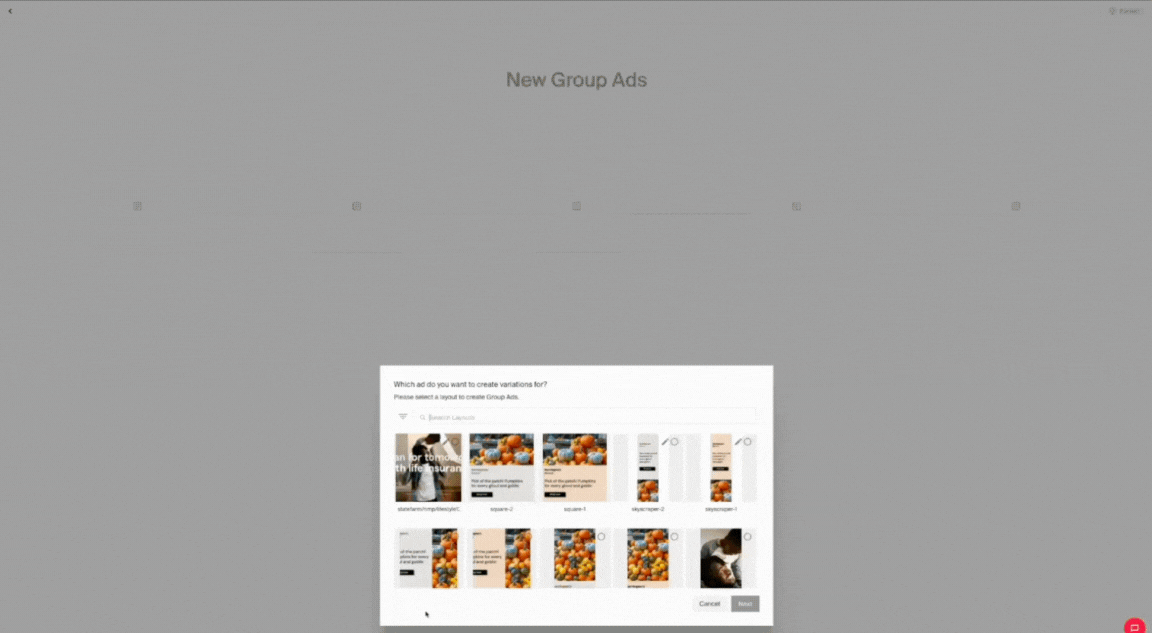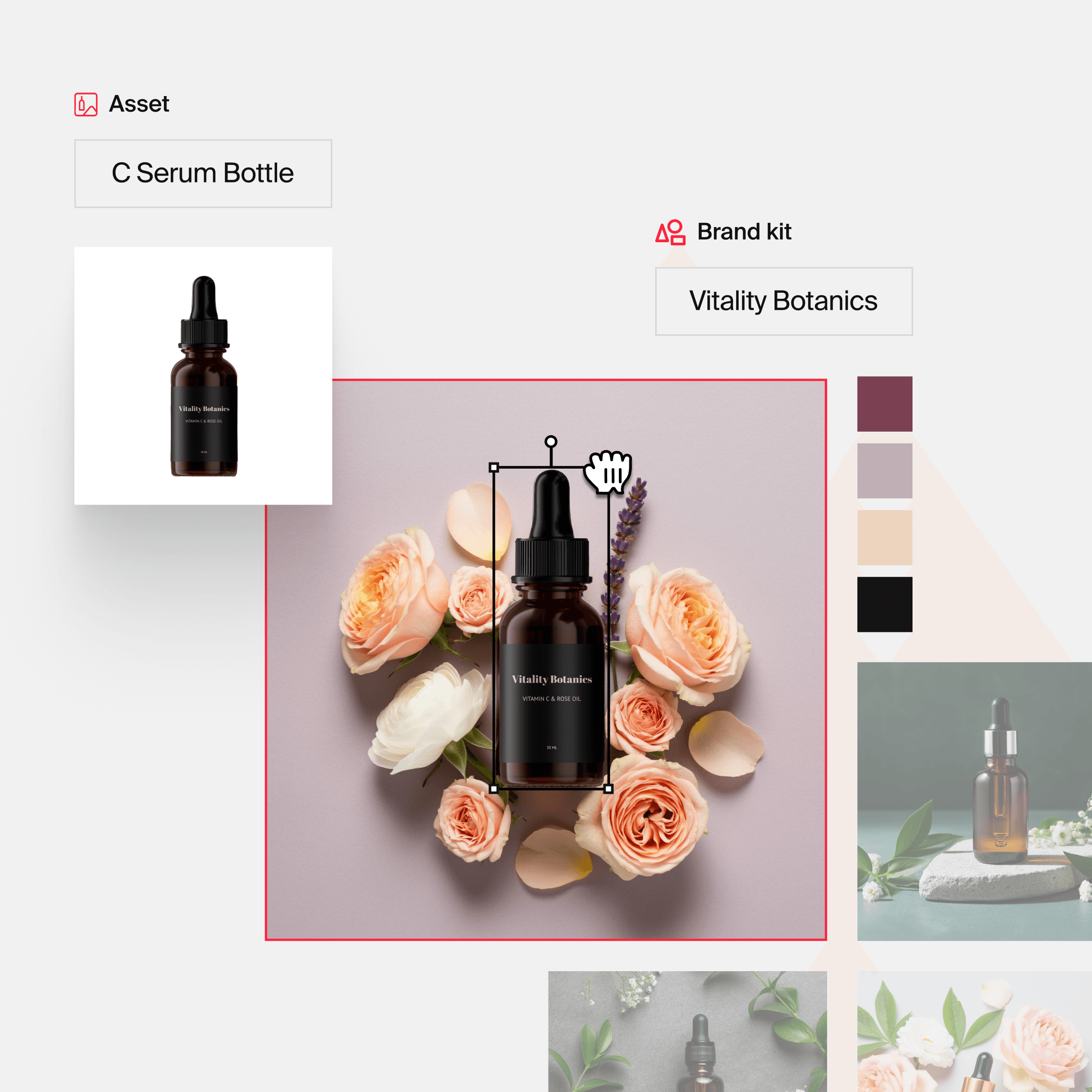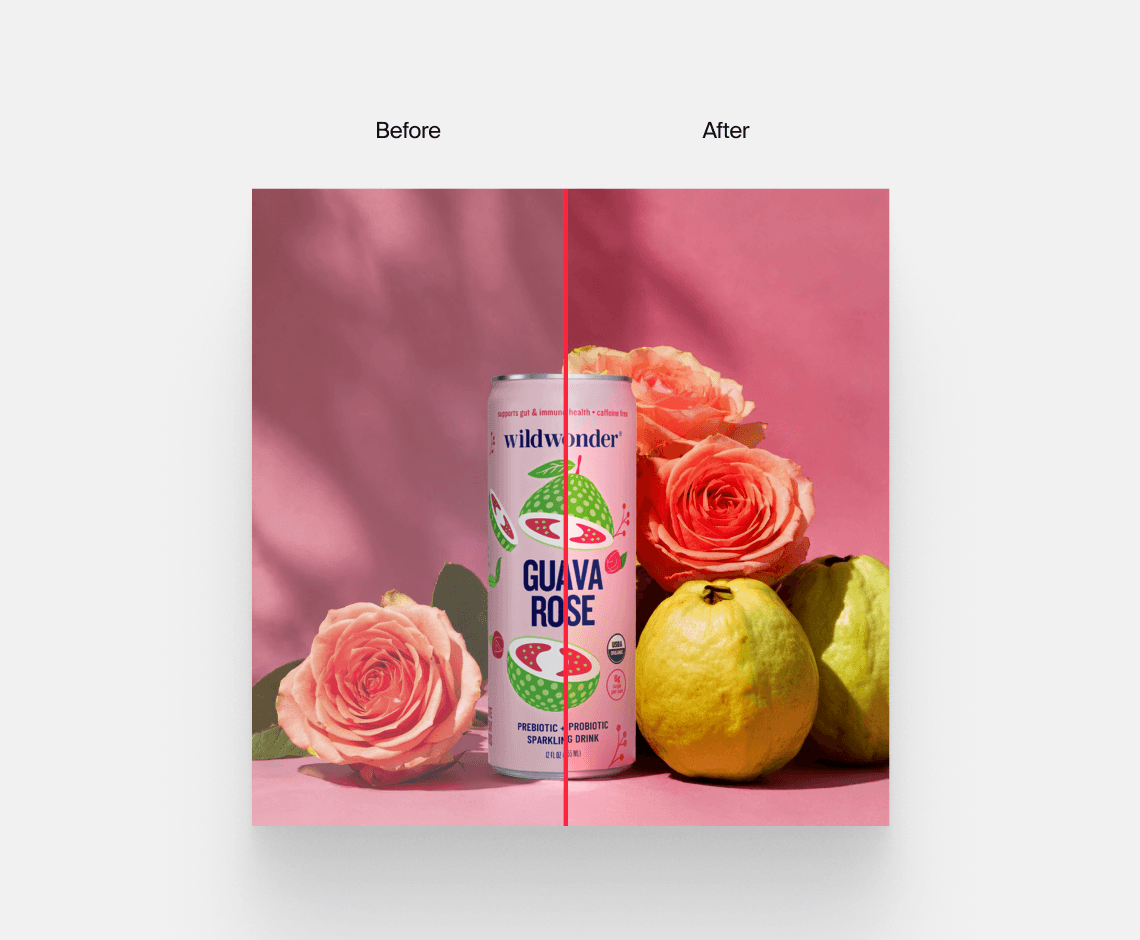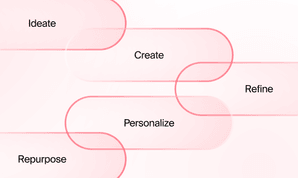AI at Work
8 Ways to Improve the eCommerce Customer Journey with AI Content Creation

Neelam Goswami · Content Marketing Associate
April 25th, 2025 · 15 min read

The eCommerce customer journey is no longer a linear path but a complex, multi-touchpoint experience that can make or break a brand's digital success. Today's consumers expect more than just a transactional interaction – they demand personalized, seamless experiences that anticipate their needs, provide instant value, and create meaningful connections from first click to final purchase and beyond. With this paradigm shift, eCommerce marketing teams are facing a critical imperative: transform content from a cost center to a strategic conversion engine. AI content creation and personalization can help you break through the barriers and bottlenecks of traditional content creation strategies.
By leveraging AI and ML algorithms capable of analyzing billions of data points, eCommerce marketers can craft hyper-personalized content that speaks directly to individual customer segments. Transforming generic product interactions into compelling, conversion-optimized narratives businesses can significantly improve the customer journey.
Why is the eCommerce customer journey important?
The role of AI in improving eCommerce customer experiences
8 ways to improve the eCommerce customer journey
Strategies to convert non-converting visitors and improve content offerings

Why is the eCommerce customer journey important?
The eCommerce customer journey is critical to effective marketing because it encompasses the entire experience that customers have online with a business, from their first point of contact to making a purchase and potentially becoming repeat buyers. Understanding this journey helps businesses identify key touchpoints where they can engage and interact with customers, offering personalized experiences that can lead to increased satisfaction and loyalty.
Mapping out the customer journey provides valuable insights into customer behaviors and preferences, enabling businesses to tailor their marketing strategies and product offerings to better meet the needs and expectations of their audience.
The role of AI in improving eCommerce customer experiences
AI can automatically analyze complex behavioral patterns, purchase histories, and customers' interactions with past campaigns to create dynamic content for every stage of the customer journey and for different customer profiles. This allows businesses to deliver contextually relevant content at the right time, tailored to each customer's unique preferences and buying behavior. Such personalized interactions could result in a significant leap in customer engagement and conversion rates. A Deloitte report says that well executed personalization strategy can increase ROI on marketing spend by 8X while also improving sales by 10% or more. Apart from this, with personalized experiences, customer lifetime value grows significantly, and brands can turn casual browsers into loyal, high-value customers.
Typeface is a leading example of a generative AI platform that understands the nuances of customer segmentation and brand governance to deliver hyper-personalized, on-brand content for any channel and market. Our AI agents can understand context, autonomously collaborate to gather brand guidelines and audience profiles, and seamlessly import data from your connected CDPs to generate content that hits the mark every time. Using Typeface's AI-first content workflows can cut down the content production time by 5 to 10X, while AI content intelligence tools also help predict and improve content performance.
8 ways to improve the eCommerce customer journey
Like most customer journeys, the eCommerce buyer journey can also be broadly divided into 3 stages - discovery, consideration, and action.
Discovery:
In the discovery stage of an eCommerce customer's journey, potential customers become aware of their needs or problems and start exploring solutions. This is where they first encounter your brand, often through channels such as social media, search engines, or content marketing. The goal at this stage is to attract attention and generate interest by providing valuable content that resonates with the audience’s needs. Establishing a strong brand presence and offering educational or inspirational content helps to build initial trust and curiosity, encouraging potential customers to delve deeper into what you offer.
Marketing success at the awareness stage is primarily characterized by increased brand visibility and engagement with the right audiences. Some key indicators of success at this stage would be:
Higher levels of social media engagement
Improve search rankings for relevant keywords
Increased website traffic
Gaining new subscribers for your newsletters
AI content creation can help at this stage by creating tailored content for broader audience segments. Using AI to generate targeted social media ads, informational blog posts, and captivating product imagery can bring down your content's time to market significantly.
1. Creating social media ad campaigns
Social media is one of the top channels for product discovery, making social media advertising imperative in eCommerce marketing today. AI content creation tools can craft platform-specific content that dynamically adapts to each social media channel's unique requirements and audience expectations. AI is helping businesses generate trend-responsive product stories that speak to the current culture and A/B test multiple variations to optimize campaigns faster, thus improving ROI on ad spending.
Ad Agent on Typeface is built to help you scale your ad campaigns, cutting down ad production time from months to days. Our Ad Agent can help marketers not just create ad campaigns from scratch but also turn a single ad into multiple variations, optimized and resized for different channels and audiences.

Creative automation with Typeface Ad Agent
Ad Agent can also automate your workflow to scale, customize, and localize ad copy and creatives. You can easily import pre-approved text, headlines, creatives, and brand elements to create variations of the same ad without having to go through extensive redesign and repetitive approval processes. This also makes it easier to test out campaign variations with different visuals, tones, and messaging while maintaining brand consistency.
2. Creating and optimizing SEO content
SEO blogs play a crucial role in the discovery stage, enhancing visibility and driving organic traffic to your site. Google says that highly confident buyers (with high category knowledge) are 18X more likely to make decisive purchases and recommend your brand to friends and family. Well-optimized, informative blog content can help impart this knowledge and build confidence within your audience by targeting relevant keywords and search queries that align with what potential customers are exploring.
AI content creation tools can streamline blog writing and SEO optimization. From content ideation to keyword optimization to generating high-quality first drafts, AI can reduce content production timelines by 50-90%.
Typeface’s SEO capabilities help ideate, research, and create content for blogs and landing pages while also optimizing the content for search with relevant keyword targeting. Our AI agents can understand natural language queries and instructions which means you don't have to master prompt engineering to get your desired output. For instance, a simple request like "Write a blog post on fall fashion trends" should be enough for the AI to understand the context, carry out competitive research from the top-ranking pages on this topic, and create a keyword optimized article. You can further support the AI with reference documents or URLs to use as grounding content for more accurate outputs.
Content explainability on Typeface analyzes the generated content and gives it an SEO score based on how well it is optimized for the target keywords and length. It can also tell you how closely it aligns with the target audience and brand guidelines as well as offer optimization suggestions to improve on these aspects.

3. Using AI image generation capabilities for dynamic visual content and product imagery
Compelling product visuals are a key to attracting new customers to your brand. AI is revolutionizing product photography by offering e-commerce businesses the capability to create high-quality visual content without the costs and hassles of traditional methods. Advanced generative AI technologies can now transform basic product images through intelligent background modification, style transfer, and contextual rendering, allowing businesses to generate multiple product visualizations instantly.
For eCommerce businesses with an extensive catalog, Typeface's AI product photography solutions can generate hundreds of professional-grade product images in a fraction of the time, while maintaining high-quality visual standards that speak to your brand identity. The Visual Inspiration Studio on Typeface houses hundreds of pre-set inspiration shots that you can customize with your product assets.
You can also craft product shots through intuitive design — arranging products and decorative elements on the canvas, then using natural language prompts to refine the final visual composition. The Magic Prompt feature on Typeface enhances your AI image prompts by adding technical details and modifiers (such as lighting, camera angle, and more) to give you professional quality outputs. The integrated Brand Hub ensures that every generated image maintains strict alignment with established brand guidelines, preserving color palettes and stylistic consistency across all visual content.

Brand-aligned product photography using AI
Typeface's innovative Product Preservation and Harmonization technology solves a critical challenge in AI-generated imagery: maintaining the precise visual fidelity of your products while seamlessly integrating them into dynamically created scenes.

Product Harmonization on Typeface
Consideration:
The consideration stage in an eCommerce customer's journey is when potential buyers are actively evaluating whether to purchase a product or service, comparing different options, and seeking more detailed information to inform their decision. They might read product descriptions, product or category pages, reviews, and comparisons, watch videos or tutorials, or explore FAQs to understand how offerings meet their needs.
Providing transparent, compelling, and comprehensive content is crucial to building trust and credibility and guiding them closer to a purchase.
Usually, marketing success at this stage in the customer journey would mean:
A rise in traffic to specific product pages
An increase in the number of potential customers opting in for newsletters, webinars, free trials, or downloadable resources
An uptick in customer inquiries through chat, phone, or email
Customer reviews and feedback can influence new customers at this stage
AI content creation tools can make an impact here as well.
4. Creating compelling category pages and product descriptions
Category pages serve as critical navigational and discovery zones within eCommerce platforms, acting as strategic landing areas that guide customers through product collections and help them understand broader product ecosystems.
Creating product descriptions that truly resonate with different customer segments is often a challenge for businesses, especially when the product catalog is vast. However, product descriptions play a huge role in driving customers closer to a purchase. Descriptions that are comprehensive, professional, and
Typeface can create category page content and product descriptions from your product documentation, with on-brand narratives that provide rich context and meaningful guidance for shoppers. To generate persuasive product descriptions aligned with your brand, use Creative Agent - a multimodal AI agent that serves as your primary content creation resource. Our AI agents function like a team member, understanding your objectives expressed in normal conversational language. Tell the Creative Agent what you're looking for - for instance, "Create engaging product descriptions for all the products in this catalog for our eCommerce store" - and provide the documents or URLs for context.
The Creative Agent will collaborate with the Brand Agent to understand your branding and audience requirements set up in Brand Hub, and generate tailored product descriptions aligned with your objectives and target market. AI allows you to create product descriptions for hundreds of products in a fraction of the time it would take with manual copywriting, while also ensuring consistency in quality and compliance across global teams. Typeface also seamlessly integrates with your data platforms and digital asset storage platforms, allowing you to easily import product documentation into your AI content creation workflow.

5. Creating impactful email marketing campaigns
Email marketing and eCommerce go hand in hand, more so during the consideration period. Be it welcome emails or your monthly newsletter, emails play a key role in engaging, converting, and retaining customers. AI content creation tools can generate hyper-personalized email content that feels individually crafted for each recipient. Using AI, you can also create entire email sequences following a customer's journey from discovery to after-sales.
Typeface's Email Agent can help you create personalized email campaigns and journeys within your approved email templates. The Email Agent can collaborate with Brand Agent to access your assets, images, brand voice, and layouts. You can personalize an existing email for a select customer segment or generate new email campaigns based on your campaign goals. The Email Agent can generate email sequences, SMS, and push notifications for a multi-step customer journey or create single touch campaigns tailored to different buyer personas.
You can further customize the AI-generated emails with your own content, replace existing images with approved image assets or AI-generated images, and refine the messaging as you like. Typeface integrates with your messaging automation platforms, making it extremely easy to publish campaigns across channels.
Decision:
The decision stage in an eCommerce customer's journey is the critical point where potential buyers are ready to make a purchase. They have evaluated their options and are now considering the final factors that will influence their choice. This stage often involves scrutinizing pricing, shipping options, return policies, and customer support to ensure a satisfactory purchase experience. But how does content help improve the customer experience at this stage? Through reassuring self-serve material that answers all their questions. When customers are doing this final research before a purchase, apart from strong customer support through chat or calls, self-serve collateral such as FAQs, guides, or customer testimonials can also put them at ease.
Marketing success at this stage would include:
Effective use of promotions
Positive customer feedback
Repeat customers who make additional purchases
This means your content marketing efforts at this stage should focus on customer enablement and retention. Here are some ways AI content creation platforms can help with this.
6. Generating customer testimonials and case studies with Typeface
Customer testimonials and case studies are crucial for reinforcing the trust in a customer who is almost ready to purchase. Creating these using AI will be a lot faster than manual creation. You can gather inputs from existing customers through customer feedback forms, surveys or interviews.
Typeface's AI can repurpose the information gathered into structured, comprehensive customer case studies or succinct testimonials. Save your case study brand voice if you have one and apply it during AI generation to ensure that the output sounds like your brand and matches the tone of your existing case studies.
7. Generating comprehensive FAQs with Typeface
FAQs on your website or product pages can address common concerns and provide essential information that can help customers feel more confident about making a purchase. AI agents can suggest both relevant questions that customers may have around a product and surface answers to simplify information access for buyers.
Make sure to include questions around return policies, warranties, shipping policies, payment options and so on as these are some common concerns customers have at this stage.
8. Creating follow-up emails with Typeface
Content marketing does not end when a purchase is made. Following up and retargeting are equally important if you want repeat customers. Typeface's Email Agent can help you build email campaigns for the post-purchase journey as well. Retargeting buyers with new offers, new product launches or occasional reminders can be instrumental in improving customer retention.
Strategies to convert non-converting visitors and improve content offerings
Crafting data-driven content to boost SEO
Crafting content that resonates with potential buyers starts with thorough keyword research. Leveraging long-tail keywords targeted to specific products can significantly enhance your eCommerce SEO. For instance, using specific search terms like "moisture-wicking running socks for summer" rather than a generic keyword like "socks" can help tap into searchers who are most likely ready to purchase, which is a strategic advantage.
Further, understanding the intent behind search queries—whether transactional or informational—allows you to tailor your content accordingly. Tools like Google's Keyword Planner can simplify this process by unveiling keyword opportunities that align perfectly with your products. This keyword research combined with suggestions offered by Typeface can help you ace SEO content creation.
Identifying and understanding non-converting segments
Non-converting visitors, such as 'bouncers,' 'passive browsers,' and 'cart abandoners,' present unique challenges yet also offer immense opportunities for optimizing your conversion strategies. 'Bouncers' often leave after a brief interaction, while 'passive browsers' take time to explore but do not initiate a purchase. Understanding the behavior of these segments through tools like Google Analytics can shed light on where and why these visitors disengage, offering insights into areas for improvement. Insights on customer purchasing and engagement behavior can also inform AI agents on Typeface, that can suggest the next best action to improve outcomes.
Leveraging personas to address user needs
Creating detailed personas for different segments can help tailor your strategies effectively. Utilizing customer data platforms (CDPs) to generate comprehensive personas based on demographics, behavior, and preferences can transform generic marketing messages into personalized experiences. Typeface seamlessly integrates with your CDP to import these customer segments. By understanding what drives these user groups, the AI agent can better align its marketing messages to resonate with each segment's unique needs.
Elevate the eCommerce customer journey with AI
Gen AI can help build an eCommerce ecosystem where every visitor feels understood and valued, where browsing transforms seamlessly into buying through personalized engagement. AI content creation and personalization strategies help tailor user experiences by analyzing vast data, and ensuring each interaction is unique and impactful - from creating multiple ad variations to crafting personalized emails for every stage of the buying journey.
As the eCommerce industry becomes increasingly competitive, leveraging AI tools is already becoming imperative. Get a demo of Typeface or get started free to experience the transformative potential of Gen AI in eCommerce marketing.

Share
Related articles

AI at Work
Powering the Future of Personalized Commerce: Generative AI in Retail Marketing

Arushi Jain · Head of Product Marketing
January 10th, 2025 · 13 min read

AI at Work
How to Use AI for Lifestyle Photography in eCommerce

Ashwini Pai · Senior Copywriter
April 1st, 2025 · 13 min read

AI at Work
5 Ways to Get Started with AI for Marketing

Joanna Huang · Product Marketing Manager
June 5th, 2024 · 5 min read